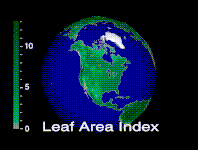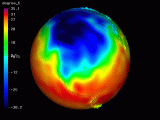 Leaf Area Index example and scale,
Leaf Area Index example and scale,
A land-surface transfer model (LSX) accounts for the physical effects of vegetation. LSX is based on the earlier models of BATS (Dickinson et.al., 1986) and SiB (Sellers et.al., 1986) and is intermediate in complexity between the two.
Up to two vegetation layers (trees and grass) can be specified at each grid point, and the radiative and turbulent fluxes through these layers to the soil or snow surface are calculated. Rain or snow can be intercepted by the vegetation and subsequently drip or blow off. For present-day simulations, vegetation attributes such as leaf area indices, fractional cover, leaf albedos, etc., can be prescribed from observational datasets, as they were in GENESIS version 1.02 from Dorman and Sellers (1989).
 Leaf Area Index example and scale,
Leaf Area Index example and scale,
However, currently the present-day vegetation is prescribed from an equilibrium vegetation model (EVE) developed at NCAR by Jon Bergengren and Starley Thompson, which produces improved global distributions (in better agreement with most datasets), and allows either fixed or interactive vegetation experiments. In addition an explicit litter layer is included on the soil surface, which is important for the soil microbial model.
For each surface grid box, a number of distinct land types can be modelled, each representing a prescribed areal fraction of the total box area. For instance, some of the box can be forest and some can be inland fresh-water lakes. Completely separate sets of LSX calculations are done for each type, and the atmospheric flux exchanges are weighted by the areal fractions and the grid-box average is passed back to the AGCM. in this way the important effects of relatively sparse sub-grid types such as lakes, rice paddies and natural wetlands are included in the model.
 Visualization of Biospheric Modeling
Visualization of Biospheric Modeling
12/8/97